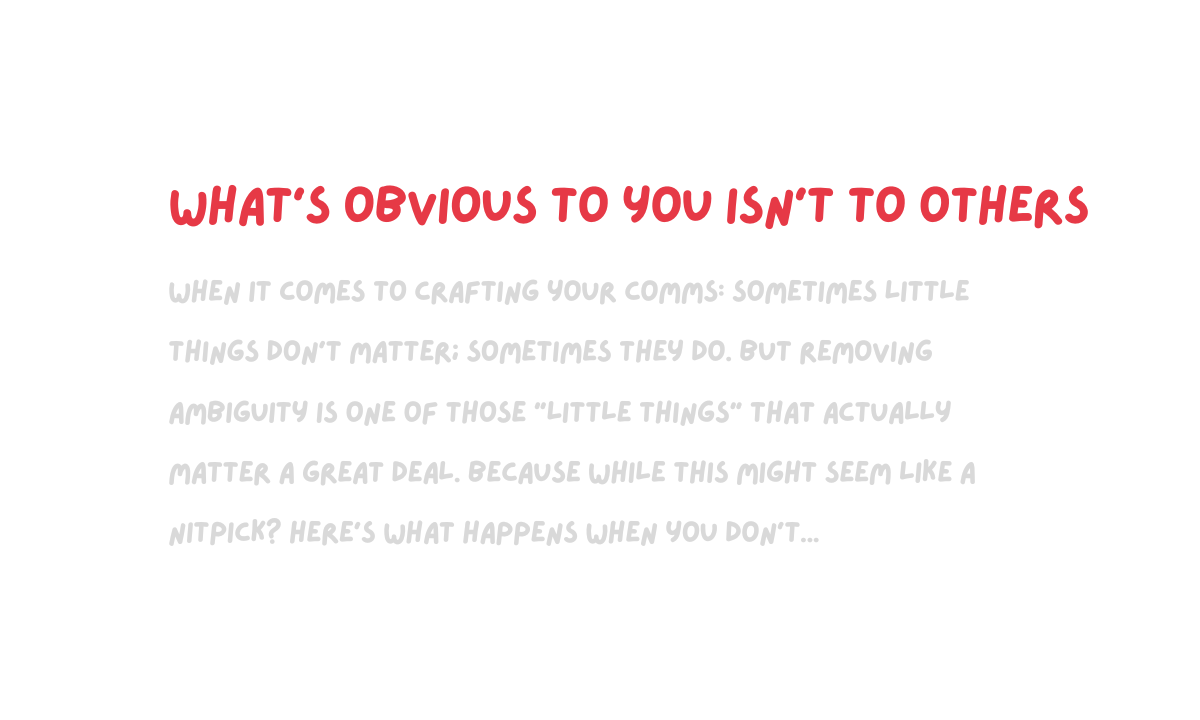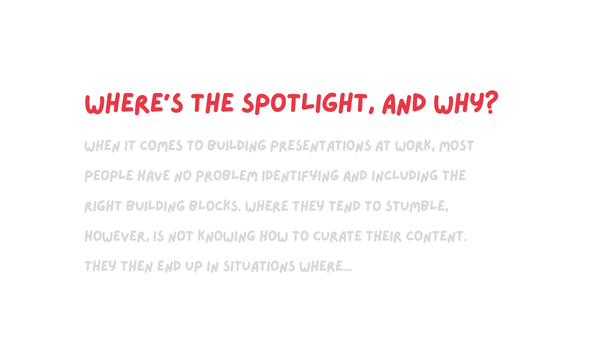Ambiguity makes everyone's lives harder (including yours)

I was reviewing a presentation the other day when something caught my eye.
Specifically, I read a slide which contained 3 somewhat confusing bullet points.
The first bullet point went as follows:
- "Initiative X sees risk due to lack of product support."
I was confused. Because I wondered:
- "Should I be worried or not? Is the initiative at risk of falling through completely (which would be very concerning)? Or is it about a delayed timeline (not ideal but manageable)? Or something else?"
As for the second bullet point, it went as follows:
- "Market Y: impact of policy change to come in Q4."
Similarly, I wondered:
- "How worried should I be? This impact: is it a lot, a little, or somewhere in between?"
Finally, this was the third bullet point:
- "Product requirements finalized, with implications for the rollout timeline."
Again, I was confused. Because I wondered:
- "Are these good or bad implications? If bad – how worried should I be about the rollout timeline delay?"
But here's the thing: it's not that the people writing the updates didn't know what they were talking about. In fact, quite the opposite.
Because once I clarified the details with them? I realized that they knew their world too well. And they assumed what they wrote should've been super obvious.
For example, for the first bullet point ("Initiative X sees risk due to lack of product support")?
Obviously they meant critical risk. The initiative requires significant product support; not having that support would practically kill it.
And for the second bullet point ("...impact of policy change to come in Q4")?
Obviously the impact is sizable and concerning. Anybody following the situation in Market Y closely would recognize that it's one of the biggest issues.
As for the last bullet point ("...implications for the rollout timeline")?
Obviously the implications were negative: more product requirements imply more lead time needed, and therefore a delayed launch.
The point I'm trying to make should be, um, obvious by now.
Because in a nutshell, what tends to happen (way more often than we realize) is this:
- We know our own worlds extremely well...
- We understand unspoken things (underlying context, stakeholder dynamics, shorthand or abbreviations, cause-and-effect relationships, etc.)...
- ...and we assume everyone else will as well.
As a result, when we're communicating to senior executives or people outside of world?
We let ourselves get away with ambiguity. And we confuse everybody else.
👋 Join 5000+ readers and subscribe to Herng's Newsletter for free:
Why this matters more than you think
When it comes to crafting your comms: sometimes little things don't matter; sometimes they do.
But removing ambiguity is one of those "little things" that actually matter a great deal.
Because while this might seem like a nitpick? Here's what happens when you don't exercise this discipline, especially in the context of exec updates:
- Those serious issues you brought to the table? They might get unintentionally downplayed or even brushed aside, due to ambiguity. And you lose trust when this happens.
- By the same token, those "simple" updates that had no cause for concern? They might get misinterpreted and cause unnecessary panic or swirl. You create angst, instead of instilling confidence.
- All of this means that you create confusion – instead of bringing clarity. Your updates do the opposite of what you actually want.
And this is precisely what we mean when we say that ambiguity makes everyone's lives harder.
Why? Because tightening up your comms isn't just a favor you're doing for your audience to improve readability.
On the contrary, it's what you should do if you want to be selfish. So you don't have to waste your own time clarifying the confusion your comms have created.
(Not to mention the additional effort required to re-build trust and remedy your reputation!)
So what is the opposite of ambiguity? It's precision, of course. But this is easier said than done.
Because as you attempt to cut down on ambiguity and optimize for precision? Make sure you also watch out for a couple common pitfalls in the process.
#1 It's not a license to ramble.
Optimizing for precision does not give you a license to include anything and everything. That's counterproductive. You'll still lose people's attention.
For example, here's a bullet point that has over-optimized for precision, at the expense of any trace of readability:
- ❌ "Our data-sharing partnership with Partner XYZ (in markets A, B, and C) is due for renewal by Q4, but is at risk of falling through due to disagreement over the revenue-sharing structure, which was revised on a one-off basis in Q1, but has now led the partner's finance and legal teams to demand a closer look at the terms again, thereby causing us to fall at least 60 days behind on our renegotiation schedule."
Of course, sometimes the fix is rather easy. For example, remember one of the earlier bullet points in the story:
- ❌ Concise, but imprecise: "Initiative X seeing risk due to lack of product support."
- ✅ Concise, and still precise: "Initiative X at risk of seeing 3 to 6 months of delay due to lack of product support."
Sometimes, however, you'll have to make trade-off's. You might have to sacrifice a bit of concision for precision – or vice versa.
- 🟡 Precise, but could be more concise: "Our new product is on track for public launch by end of Q3, but with 3 fewer features vs. originally planned, due to challenges with 2 out of the 5 external measurement partners."
- 🟡 Concise, but could be more precise: "Our new product is on track for Q3 launch, but with 3 fewer features vs. originally expected due to partner challenges."
What you determine to be optimal in the end will depend on your level of finesse, your understanding of your audience, and the stakes at play.
👋 Subscribe for free to get Herng's newsletter directly in your inbox.
#2 Don't just use numbers. Contextualize them.
To achieve precision in your comms – use numbers whenever possible.
However, just using numbers alone isn't enough: you need to make sure they're properly contextualized.
Otherwise, you'll just create another form of confusion.
For example, consider the following update:
- 🟡 "Engaged 4 agencies this quarter and scaled our new product to 20K premium users via a long-term licensing partnership."
Is this precise? You bet. Is this concise? For sure.
So what's the issue?
Well, the issue is this: no one (outside of the person writing the update) will know how to feel after they read this update.
Instead, they're left scratching their heads, because they're wondering things like:
- "This seems like... good news? 20K users seems really impressive for a new product that just launched last quarter."
- "Also, maybe this isn't that impressive, because it's only 4 agencies. Given how many agencies are out there, it'll take forever to scale our product meaningfully, no?"
- "Is the person writing the update trying to ask for help (because things aren't moving fast enough), or actually sharing good news (because it's a breakthrough)? I really don't know where they're going with this."
The issue here is simple: citing numbers alone doesn't help you achieve precision. You need to learn how to properly contextualize – otherwise you simply create more confusion.
Consider, therefore, what a better-written update could look like:
- ✅ "Engaged 4 agencies this quarter and scaled our new product to 20K premium users via a long-term licensing partnership; likely to deliver annual goal of 10 agencies and 30K premium users (= X% market penetration) 2 months ahead of schedule."
Quick Recap
- Ambiguity in your comms creates unnecessary confusion, angst, and even distrust. This makes life harder for everyone – including yourself.
- Remember: What is obvious to you is not always obvious to everyone else. If what you write doesn't make sense without you in the room? Your ability to influence will be capped.
Other Useful References
- Size doesn't matter (when it comes to words)
- Why a "simple update" is never actually simple
- How to contextualize and tell effective stories (5 tips)


